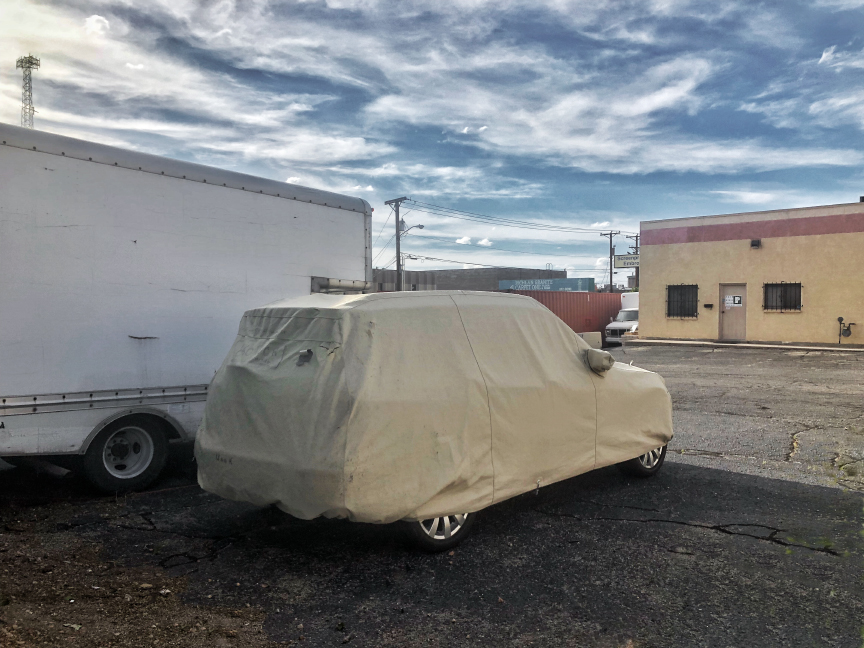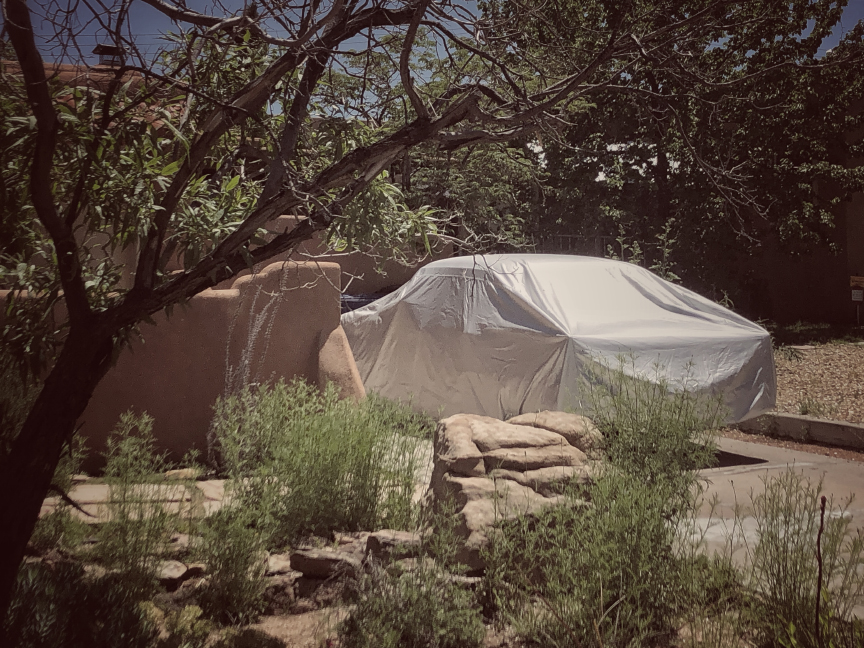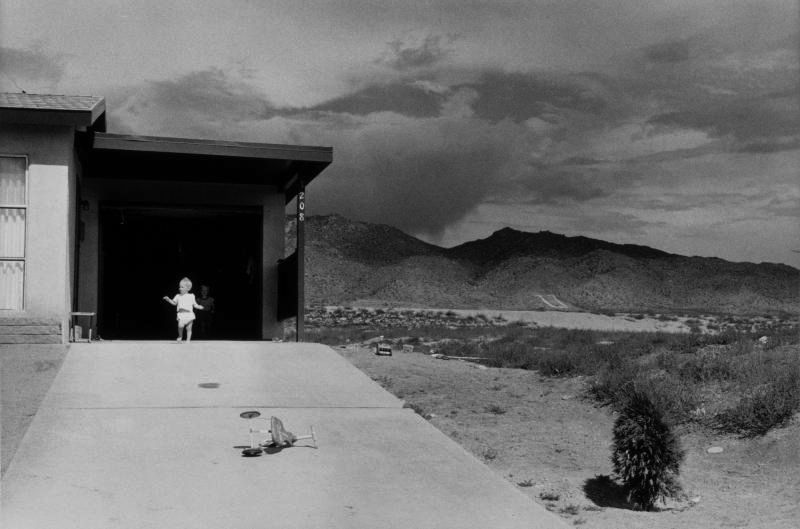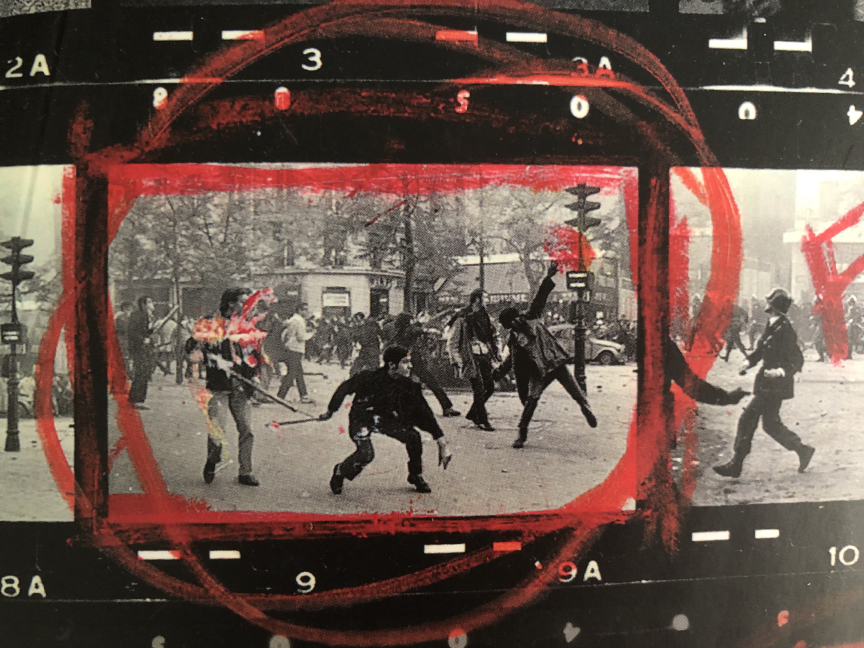Silence might be golden, but right now I got nothing to shine.
2019: 20 (Somewhere Else)
Sometimes work life gets in the way of personal life. This was one of those weeks. In the interest in keeping up this weekly blog posting, I’m at least sharing a few images I made while focussing on a TV production. Long hours in prep and two 12 hour days on set left little time for anything else. I did find a few covered cars out in the field, so not a total disengagement from my personal work. See you next week.
2019: 18 (Revisited)
Wandering back through work from last year. It’s been a liberating experience revisiting work that was published in one way, and now processing them in a completely different manner. Any reluctance I may have felt about messing with the “sanctity” of previously published work has disappeared, as I find infinite new ways to express myself, all courtesy of Lightroom.
As I write these words, I’m sitting in my office, scanning negatives from a recent shoot on Good Friday. Scanning film, re-working digitally captured files, the give and take between old methods and new… such is the life of a 21st Century photographer.
Covered cars remain an obsession for me; serial photography has its rewards.
2019: 17 (Holding Pattern)
After a chill Easter weekend in Santa Fe, I guess my body rebelled against too much rest and relaxation and I ended up getting a wonderful, early Springtime cold. This one has been stubbornly holding on for the past four days, and my frustration continues to mount.
In the meantime, it’s giving me time to stop and reflect on what might come next for me, photographically speaking. I have a few ideas for new projects, but nothing concrete, and a couple of these ideas will push me out of my comfort zone for shooting. I’m also sitting on about 15 boxes of Fuji peel-apart film for my Polaroid 360, and once that film is gone, it’s gone. Since it’s been discontinued, I just can’t justify paying $50 per box on Ebay. At the same time, I’m struggling to come up with a worthy project that will do justice to the unique quality of that film. I’m open to suggestions, dear readers.
I’m trying to be patient and ride out this “in between” time, as I know I’ve been on a tear creatively for the past year or so, so time to breathe is welcome, even if it’s through clogged nasal passages.
2019 : 16 (Good Friday)
Every year for the past 4 or 5 years, on Good Friday, I’ve made a sunrise climb to the top of Tomé Hill, outside of Los Lunas, New Mexico. This is one of two main Catholic pilgrimage sites in the state, a much smaller, more intimate kind of experience than one would have up north in Chimayó. I like it because it is low-key. is a fairy challenging, yet short hike to the top of the Hill, and it always rewards my waking up at a criminally early hour with a glorious sunrise over the surrounding valley.
Though I’ve shot here numerous times, I tried to take a different approach this year and devote myself primarily to shooting on film. Those resulting images will have to wait for developing and scanning. I did take a few shots with my iPhone as well, but restricted myself to capturing in high contrast, black and white.
Though I am pretty much by this point an agnostic, there is still something about the Catholic exercise of faith that draws me in creatively. And spending a sunrise morning on top of a hill above the beautiful New Mexico desert is not a bad way to start a day.
2019: 15 (Improvise)
Besides photography, my other current passion is improv. I love creating with a team of like-minded performers, reacting to each other in the moment. In improv, you work with a suggestion, and add something to that suggestion. The method is known as “yes, and…” and it is the core of positive creative development in improvising.
The relevance of this approach extends into other areas of my life, both professionally and personally. Case in point, I am currently part of a group of local photographers who have the opportunity to mount a group show of our work. We have a unifying theme to the show, and it has been an interesting process seeing how our work compliments each other. What has been even more amazing, though, has been the improvisational nature of hanging the show. We worked as a group this week to hang the show, and it was a great exercise in collaboration, of “yes, and”-ing each other as we curated the groupings of images.
The show is shaping up to be something really special. I’ll be sharing a more formal announcement about the details soon. It’s been a refreshing exercise in teamwork and support and for that I am particularly grateful.
2019: 14 (Inspiration)
Busy week for me photographically. The sales of my latest self-publishing projects are going well. I made a vow that any money brought in BY my photography can only be spent on things FOR my photography. With the income from book sales, as well and a photo shoot I recently completed for a local musician (more about that project will emerge sometime soon) I was able to purchase some tools and treats.
The behemoth film camera above, affectionately known as a “Texas Leica” now has a place in my arsenal. The Fuji 6x9 will be my non-digital toy for the foreseeable future. I am using it to shoot 35mm panoramic, and my early tests look promising.I’ll share some scans soon.
I also bought a couple of photo books. Nathan Lyons has been a huge influence on me, ever since I saw work from his groundbreaking book “Notations in Passing” when I was back in college. Lyons died in 2016, and recently was the focus of a retrospective exhibit at the George Eastman House. The catalog from the show is the book titled “In Pursuit of Magic” and is a recent addition to my personal library. I plan on studying this work deeply and thoroughly.
Lee Friedlander’s “The American Monument” is another book I have coveted for some time. Originally released in 1976, it has been out of print for decades, and either ridiculously expensive or downright impossible to find. Until now. A recent re-issue made my wish for a copy finally come true. And what a beautiful piece it is. A huge (nearly 11” x 17”) format, with each page printed on one side. The book is flat bound with side grommets. The image reproduction is absolutely beautiful. This is one of 2000 printed, and I will treasure it for years to come.
Finally, a tip of the hat to my photographic compatriot Justin Thor Simenson. We have been mutually supporting each other’s work for some time now. I was recently presented with a very exclusive edition of his “El Burque” zines, compiled and bound in an 8.5 x 11” magazine format. The work is great, and the presentation in this format really befits the long term nature of his series. Justin has a Patreon page, which you should consider supporting. It’s how I received this exclusive magazine, and the guy is so prolific, you’ll be excited to be receiving new work from him on a frequent basis.
Albuquerque, New Mexico, 1957, Garry Winogrand. Image copyright Estate of Garry Winogrand, courtesy of Fraenkel Gallery
Worth A Thousand Words: Garry Winogrand
Though he would loathe the distinction, Garry Winogrand was one of the great “street” photographers to have emerged in the late 1950s. He was championed by John Szarkowski at the Museum of Modern Art, but oddly his reputation has faded over the past few decades. I think that photographers such as myself from certain generation know of his work, but his name seems to have been slightly forgotten amongst a younger audience. Which is a shame considering how popular the genre of street photography is today. Going back over his work, especially those created during the height of his powers in the early 1960s, would be an enlightening experience for any young photographer unfamiliar with his body of work. Admittedly, some of Winogrand’s work has not aged well. Especially his series titled “Women Are Beautiful.” This specific work feels very different when viewed from a contemporary standpoint compared to the times when they were originally created; one could argue against this kind of “photographic male chauvinism.” For some context, I highly recommend viewing the documentary film which came out last year “Garry Winogrand: All Things are Photographable” by Sasha Waters Freyer.
There is one photograph in particular by Garry Winogrand that has stayed firmly in the back of my mind since I most likely first gazed upon it as a young photo major in college. Growing up in New Jersey, I had a somewhat narrow view of the world for sure and my impression or imagination of what the rest of the world or even the rest of the United States might look like was shaped primarily via television, movies and especially, photography. The image that I am focusing on today by Winogrand was taken in Albuquerque, New Mexico In 1957. Little did I know when I looked at that photo for the first time that I would eventually find myself living in New Mexico. That photo really shaped what I thought this place might look like, having never visited it.
So looking at this photograph what do we see? The outer edge of some tract home. A garage door is open. In the darkness a child stands in the back, while right at the threshold of the garage, lit by bright sunlight is an infant… walking out into the world… arms partially outstretched. The driveway is sectioned cement. An oil stain appears about a third of the way down and closer in the foreground is a small tricycle on its side. As we looked to the other half of the photograph, we see barren desert stretching off to a mountainous horizon. Storm clouds appear over the mountains, and a white letter “U” is seen against the mountain (most likely representing the University of New Mexico.) The desert scrub that extends up to where this house sits is punctuated in the lower corner of the photograph by a small shrub… possibly a cactus or some other native desert plant.
There are many things I find compelling about this photograph, regardless of the fact that I live a few miles away from where it was taken. It was shot in 1957, the times were the height of Eisenhower era, post-WWII boom. The middle class was continue to expand, and the west (or in this case, southwest) was experiencing a population burst, thanks in large part to the expanding interstate highway system, the ubiquitous automobile and the availability of cheap land to fill up with suburban housing. This is all apparent in this photo by Winogrand. What I find though, against a manufactured backdrop of optimism, there is a dark sense of foreboding emanating from this scene. The storm cloud, of course, brings a degree of menace to the environment. There are other clues. The tricycle on its side, a hazard to a driver, perhaps. A potential cause of injury for the boy in the background? The two children are unattended. Perhaps not a shocking then as it would most likely be to contemporary parents, but odd that a stranger with a camera could roll up and shoot this photo. What else could a passing stranger be capable of here? And this house… on the edge of a development, with nothing but open desert at its side. What potential threats linger just a few feet away from this house? As many of us who live in the desert know, it is a dangerous place. It would be too easy for a child to wander off, get lost, fall into a dry river bed, stumble into a thorny plant, or perhaps encounter an animal or a reptile that could easily inflict harm.
The fact that this house appears to sit at the far edge of humanity is quite striking to my eyes, as I know the part of the city where the house is located. In the 60 plus years since the image was created, huge amounts of development have occurred in Albuquerque, and the entire area of the city where this house sits is unrecognizable from how we see it here. The majesty of the Sandia Mountains shown off in the distance would be completely obscured if one were attempting to recreate this photo today. While, in the other direction on the outer edges of Albuquerque West Side, one could find, I’m sure, the 21st Century equivalent of the scene Winogrand stumbled upon back in 1957.
The same house, 60 + years later.
Out of curiosity, I decide to try to find this location for myself. And thanks to some internet sleuth work, I did indeed find it (thank you Google Maps.) On a non-descript side street in the Northeast Heights of Albuquerque, sits the original house from the photo. It still has some of its characteristic details, most specifically the concrete driveway, the front windows along the left side of the image, and the telltale beam along the right side of the garage (though the house numbers are long gone, the front curb has the numbers 1208 spray painted on it.) As you can see, the sweeping view of the mountains is gone now, blocked by a neighboring house, although there is a tiny bit of the range still visible just beyond the backyard fencing. I experienced a kind of self-induced déjà vu while standing in front of the house. I was waiting for someone to walk by and acknowledge the significance of the location. Alas, only the midday sun and a slight springtime breeze provided whatever pinch of reality the location was able to muster.
2019: 13 (Au Revoir, Agnes Varda)
Earlier this week I watched a set of short documentaries by French director Agnes Varda. The films all revolved around the theme of photographic representation of reality, or of a straying from reality, more precisely. Viewing these films was oddly and sadly coincidental, because as it turned out, Varda died just a few days later. If you are unfamiliar with her work, I encourage that you seek it out. She was at the leading edge of the French New Wave of cinema, the infamous boys club of greats like Godard and Truffaut. Her work never lost a sense of wonder and humility.
On a lighter note, I’m excited to be talking part in a group project with a circle of Albuquerque-based photographers. Too soon to spill the details, but framing up some work is getting me excited for this new opportunity. More news to come.
Lastly, I’d like to give a plug to a local podcast I’ve been enjoying lately. It’s called “City on the Edge” and it’s a great exploration of this weird, dangerous, lovably perplexing city I call home. They recently did an episode on Ernie Pyle that I found quite fascinating.
2019: 12 (Magnum: Contact Sheets)
I made two resolutions this past New Year’s Day. One was that I would write a blog entry on this website once a week. I have kept this up for 12 weeks, so I consider it a good start as we round the corner on the first quarter of 2019. The other resolution I made was to purchase at least one photo book every month. I was excited when the most recent purchase arrived in the mail. As you can see it is “Magnum: Contact Sheets.”
The book is a fantastic look “behind the curtain,” so to speak; to see the rolls of film that have yielded so many historic, incredibly memorable icons of 20th-century photography. Looking through this book triggered so many memories for me, recalling the days when I was strictly a film photographer. Exposing 36 exposure rolls of film, developing the film myself, and then finally making a contact sheet of each roll. Finally seeing all of the images I captured with my camera. There is still a feeling of magic for me when I look at contact sheets. Hence my joy of adding “Magnum: Contact Sheets” to my library. I love looking throughout the book and seeing the photographers’ markings… isolating the specific image that they chose to print, seeing that frame on the contact sheet marked in bold grease pencil.
Though shooting digital photographs has many advantages, there is something lost when there is not a tangible record of the photos that came before or after the ones we choose to show the world. I highly recommend this book. It should be part of any serious photographers personal library. It might even inspire you to grab a roll of film and shoot “old school.”





























